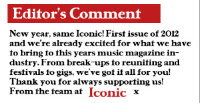To start off my contents page, I basically set out where I wanted
what pictures to
go where.
I used the two models on my front cover as my main photo, and another photo I took of another model for another article.
I also re-used my front cover on my contents page to advertise subscription of my magazine.
I used a
basic white background, so it was easier to edit on and didn't clash with the other colours I wanted to use, plus a black background seemed tacky.
I started placing the
background for my headers on my contents next.
This broke down what I wanted to go where a little bit easier for myself when I came to including more text etc.
I used the
same font for the Iconic on my contents as I did on my front cover, to keep the style and theme going throughout.
I also kept the whole
black, red, and white theme as well as similar or same fonts.
Next, I included a bit more text.
Using the text tool on
photoshop CS4, I was able to position where I wanted the text and how wide I wanted the text box to be etc.
I stuck with a
white theme for the font colour for the Band Index and headers, as white on both red and black background stood out more than any other colour would.
The band index to me was a good feature to include on my contents. It shows what bands are included in the magazine and what
type of genre the magazine is going for.
The next step was to put in some writing for the articles etc.
For each article page number, I gave a
brief description below of what that page was about. Using a different font, the description isn't as highlighted as the main attraction, which is the title.
I got the idea of an 'Artist Highlight' from Q Magazine. Giving Bloc Party a section on my contents page
highlighted the genre of my magazine too.
I used the page numbers in a
different font again, and colour, to highlight them and make them noticeable for readers.
FINISHING PRODUCT:
To complete my contents page, I added in the subscribe section by highlighting the important factors, such as the website, to
grab the readers attention.
I also included an
Editor's Comment in my contents page, to give the magazine a friendly and warm feel to it.
I also added a big
'SUBSCRIBE' to the small photo in the left hand corner, to notify to a reader that the magazine does a subscription.




















































